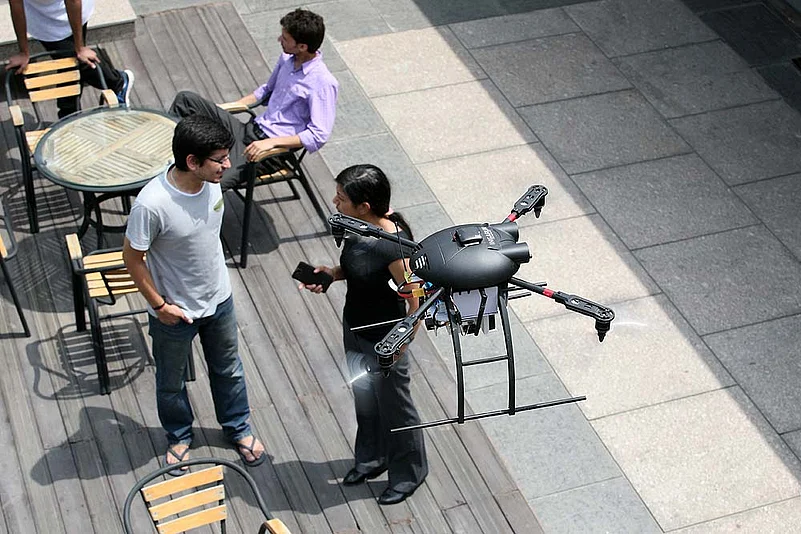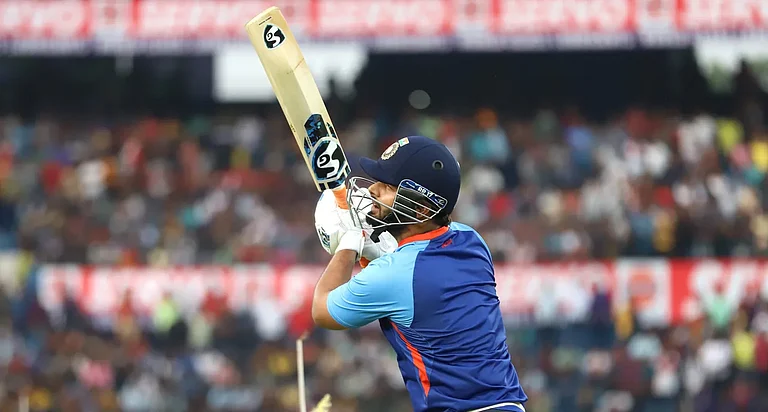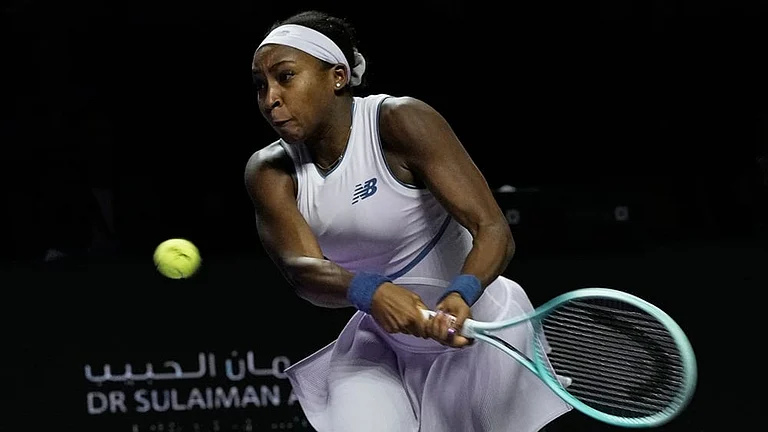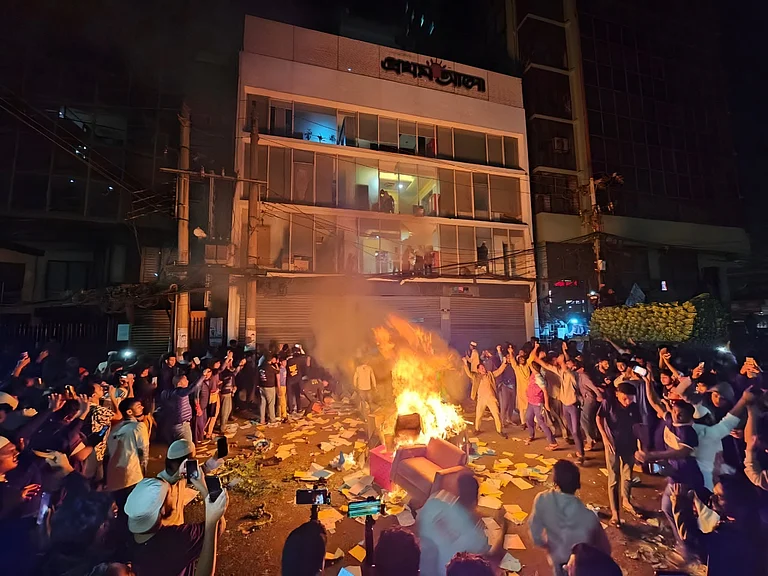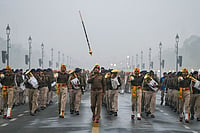Who Can Fly A Drone
- Cannot be used for commercial and recreational purposes without permission
- Cannot be flown above 500 m, near airports or indoors
- Permission has to be taken from the police, home ministry and DGCA
- There are concerns over privacy, ecurity etc
***
Arti Kishen wanted her destination wedding at the Udaipur Lake Palace to be exquisite. It wasn’t to be for just a day, it had to live on in the memories of everyone forever. And that meant capturing every bit of it, and from every angle possible—including the bird’s eye view. “I couldn’t compromise on the wedding cinematography,” she says. The answer: here comes the drone.
Bug-like beings with four legs, 4-6 wings, their black and white bodies dotted with tones of yellow, orange and red. They can fly high, are extremely perceptive, and can increasingly be found hovering over weddings, sports matches and music concerts, zipping over fields, real estate and industrial sites. These new giant insects—drones, as the ‘circuit’ calls it, and unmanned aerial vehicles (UAVs) for the more technically advanced—are monitor-controlled flying devices enabled with GPS and fitted with cameras. We first heard of them from the warzones but they are now in civvies and recording happy and sad events down below.
Aakash Sinha, of drone manufacturer Omnipresent, claims the device is capable of a lot more than what the common man can imagine. “Drones are now being used for crowd control, aero-journalism, landscape photography, agriculture, even to create makeshift mobile signal hotspots,” he says. Indeed, things have moved so far ahead online retailers like Amazon and Jabong are looking at drones for quick deliveries. The drones-as-delivery-boys buzz first started here in early 2014 when Mumbai’s Francesco’s Pizzeria put out a video of one delivering a pizza to a high-rise. “It was the opening of a Francesco’s outlet and we wanted to make a stellar entry. We hired a drone and filmed it delivering our pizza to a friend,” says branch manager Sijo Palikad. The market had opened earlier in 2013 with companies like Quidich and Airpix offering “aerial solutions”.
The demand has since skyrocketed, so much so no self-respecting event manager will be caught dead without a drone on stand-by today. Rishabh Sood of wedding planners, Candid Tales Company, says they use drones in 60 per cent of the nuptials they cover. Many outdoor events like the Bacardi NH7 Weekender, India Bike Week, Supersonic etc have the bugs hovering around. Bollywood isn’t far behind, Kick and Baby’s high-falutin’ shots were made possible by drones mounted with high-definition cameras.
But is a lot of it just “show culture”, a new toy for the rich? Freelance photographer Rajesh Luthra, himself an avid user of drones in his projects, admits to the possibility. In the same vein, Sood narrates an instance where a couple came to him asking for the price of a drone for a day. “I gave them the price and they asked for a discount saying they didn’t want anything filmed, just the drone flying so people could see!” he says. Which is perhaps also the reason drones are a must for ‘events’ at clubs, cafes and bars. “It gives the patrons just that extra ounce of glamour,” points out Karan Chawla, director at Backyard Cafe, who often uses drones on his terrace. But there’s a fun element to it too. Professional DJ and some-time photographer Navendu Malik says drones are great to scale heights and is the next thing for adventurers who want to capture the road ahead. He recommends it to anyone who can afford it. “It’s a bit of fun in the weekends,” he says.
As of today, drones can cost anywhere between Rs 25,000-50,000 a day, with four batteries which last for 15 minutes each. “It’s not the drone but the tech support which pushes up costs. Not everyone can operate a drone,” says Neil Gokhale, engineering head at Quidich. The whole contraption can cost between Rs 1.5-50 lakh, depending on the technical sophistication and size. A more sophisticated one was used by the National Disaster Response Force (NDRF) in recent crisis situations. “We first used it in 2014 to find students washed away by the swirling Beas in Himachal Pradesh. In ’15, in the Nepal quake we used it to pinpoint areas where people needed aid,” says Pandit Ithapa, deputy commandant, NDRF.
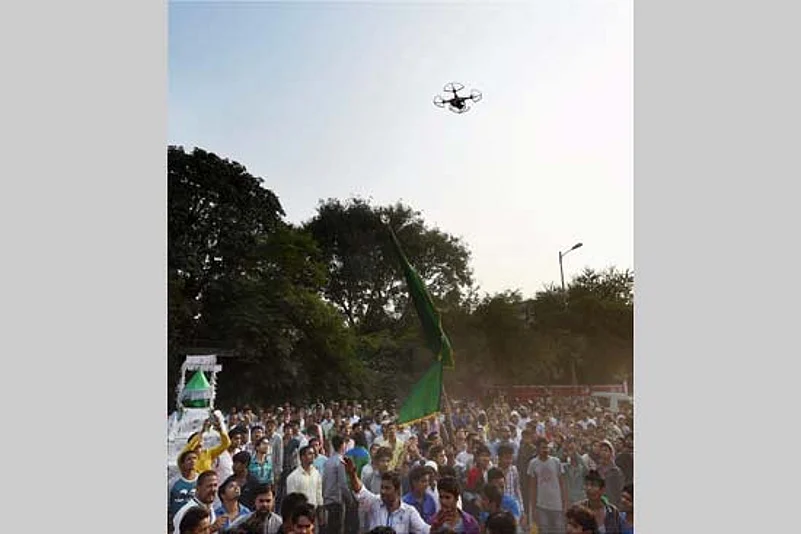
A drone monitors crowds at a Muharram rally in tension-hit east Delhi, November ’14
However, the high cost of the equipment means most public and private organisations outsource the drones for their research. “We have used UAVs to chart real estate, conduct windmill inspection for clients and also do volumetric analysis of stock piles in mining,” says Shinil Shekhar, founder of Airpix. A few other examples: the Panna tiger reserve in MP has used drones to keep track of their tigers while the Meghalaya police department has had personnel take training on its use. ADGP Ragu Magha says they plan to use drones for crowd control and to map the city.
Right now, there are at least 25 established players making drones in India, although the business is yet to accrue investor interest. “We are mostly self-funded and rely on projects from the government and private firms to keep us going,” says Omnipresent’s Aakash. Anam Aggarwal of Funaster, which assembles and sells drones, agrees. “Drone manufacturing is still a niche market in India. Investors aren’t betting on us yet,” he says.
Unfortunately, the lack of investor interest has also resulted in comparatively slow technological developments. Indian drones still largely rely on defence organisations like DRDO for this. That said, drones continue to be imported from countries like Israel, China and Japan (in fact, India is the second largest importer in the world after the us). Retired naval officer John Livingstone, who worked with India’s largest UAV HERON, says there are several government loans and grants available from the departments of science and technology and of micro small and medium enterprises, which are looking with interest into the area of drone development.
A downside to all this are the fears that the tech can be misused. Last year, the directorate general of civil aviation (DGCA) issued a blanket ban on drones until it came out with official regulations for their functioning. But this ban has not dampened business as permissions are easy to come by. “For all big events, permission has to come straight from the DGCA, right down to the local police station. For small events, permissions from the area officers is enough,” says Sood. At Airpix, Shekhar believes that a set of regulations in place will reassure consumers and investors and help in steadier growth. “Commercial sector participation in the drone industry is likely to grow keeping in mind positive regulations,” says Livingstone.
But if it can deliver pizzas, it can also deliver more lethal stuff. A YouTube video showing a gun being fired from a drone went viral recently. One comment below the video read, “Great. Pretty sure this will now be used as evidence to bring crazy anti-drone laws and ruin the fun for everyone.” Gokhale believes the pros outweigh the cons by many a mile. “Guns? Why not a bag of bombs! But were cars banned after the Parliament attack?” he asks. He believes drones are as important a technological invention as cars or helicopters. And as with any technology, it depends on how it is used. True, bombs are being flown by drones but it’s also true that medicines are being delivered by them in remote areas in Africa where they are saving lives.
By Stuti Agarwal and Arushi Bedi






